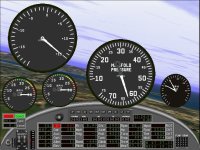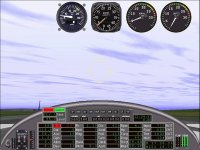One of the things that has bothered me for years is not having stock gauges either in CFS or FS98 to do the things I want.
Some of the issues have been for Fuel Selectors for unusual Fuel Tank Arrangements and Multi-engine gauges that will work properly.
A few days ago, I was trying to explain to my son why I was trying to program my own Tachometer (easy first project I hope) and wanted to show him that the FS98 Cessna Tachometer simply did not work.
Strangely enough, the Cessna gauges worked perfectly as did the Extra's Digital Tachometer.
I was surprised. I KNOW they didn't work earlier which is why I wanted to program my own.
Last night, I was looking back on my test aircraft's panel and noticed that the Cessna Tachometer had stopped working again; Its needle was pegged at somewhere near 4000 RPM while the P-51D Tach and Extra's Tach both were reading near the correct 2600 RPM value.
Have any of you seen this before? Do FS98 or perhaps FS2000 gauges work in CFS? I know that CFS2 gauges do not work in CFS..
- Ivan.
Some of the issues have been for Fuel Selectors for unusual Fuel Tank Arrangements and Multi-engine gauges that will work properly.
A few days ago, I was trying to explain to my son why I was trying to program my own Tachometer (easy first project I hope) and wanted to show him that the FS98 Cessna Tachometer simply did not work.
Strangely enough, the Cessna gauges worked perfectly as did the Extra's Digital Tachometer.
I was surprised. I KNOW they didn't work earlier which is why I wanted to program my own.
Last night, I was looking back on my test aircraft's panel and noticed that the Cessna Tachometer had stopped working again; Its needle was pegged at somewhere near 4000 RPM while the P-51D Tach and Extra's Tach both were reading near the correct 2600 RPM value.
Have any of you seen this before? Do FS98 or perhaps FS2000 gauges work in CFS? I know that CFS2 gauges do not work in CFS..
- Ivan.













